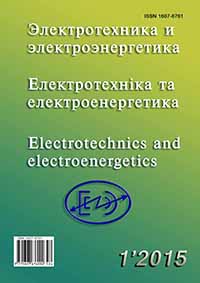INVESTIGATION OF ELECTROMAGNETIC PROCESSES OF SELF-EXCITATION ASYNCHRONOUS TRACTION MOTOR WITH REGENERATIVE BRAKING POWERED BY LIMITED POWER SOURCES
DOI:
https://doi.org/10.15588/1607-6761-2015-1-7Keywords:
self-excitation, transients, asynchronous motor, magnetization, mathematical modelAbstract
The article presents the definition of the functions of self-excitation electromagnetic processes of asynchronous traction motor with regenerative braking powered by limited power source. It is shown that the power of current synchronous generator with brake mode is not very desirable, as leading to increased fuel consumption and can reduce the value of the braking power, engine traction which develops as a result of absorption of the resistor current synchronous generator. Therefore, it is advisable in brake mode to keep rectifier closed by lowering the excitation synchronous generator so that the latter is below rectified voltage asynchronous machine. By reducing the power factor of asynchronous machine magnitude of reactive energy required for its excitation increases and increases according capacitor discharge current. Capacitor filter designed to smooth the ripple voltage mainly generates the inverter work. The increase in capacity required for this purpose is desirable to avoid the increase in the weight and volume of the inverter. Therefore, the low power factor may be appropriate to enable the rectifier and power of asynchronous machine of synchronous generator increasing its excitement. This should automatically be happened with increasing of discharge current filter capacitor installation and should be funded to some acceptable limits. The research is carried out in general terms, it can be used for asynchronous traction results in electric various seriesReferences
Родькин Д. И. Энергопроцессы в асинхронном двигателе с насыщенной сталью / Родькин Д. И., Мартыненко В. А., Барвинок Д. В., Гераскин А. С. // Вісник КДПУ . – 2002. – С. 174–181.
Шидловский А. К. Анализ энергетических показателей источника вторичного электропитания для низковольтных потребителей транспортных средств / Шидловский А. К., Юрченко О. Н., Скиданов В. М., Павлов В. Б. // Техническая электродинамика. – № 4. – 1989. – С. 27–31.
Мазуренко Л. И. Расчетно-экспериментальная оптимизация параметров емкостных систем возбуждения и анализ характеристик однофазных асинхронных генераторов / Мазуренко Л. И., Лесник В. А., Дынник Л. Н., Джура А. В. // Техн. електродинаміка. – № 4. – 2007. – С. 57–62.
Мазуренко Л. І. Електричні машини змінного струму та електромеханічні системи на їх основі / Мазуренко Л. І., Попович О. М., Гребеніков В. В., Бібік О. В., Головань І. В., Джура О. В., Шуруб Ю. В., Вербовий А. П., Романенко В. І. // Праці Інституту електродинаміки Національної академії наук України: Зб. наук. пр. – Вип 29. – К. : ІЕД НАНУ. – 2011. – С. 62–70.
Мазуренко Л. І. Електричні машини змінного струму та машинно-вентильні комплекси на їх основі / Мазуренко Л. І., Попович О. М., Гребеніков В. В., Бібік О. В., Головань І. В., Джура О. В., Шуруб Ю. В., Вербовий А. П., Романенко В. І. // Праці Інституту електродинаміки Національної академії наук України: Зб. наук. пр. – Вип 26. – К. : ІЕД НАНУ. – 2010. – С. 63–71.
Расчет предельных и регулировочных хараткристик электропередачи ТЭ-120 в режиме торможения. Разработка структурной схемы системы автоматического регулирования тормозного режима. Часть 1 (промежуточный отчет), 16/79, инв. № Б765805. – М. : МЭИ, 1979. – 58 с.
Кулагін Д. О. Проектування систем керування тяговими електропередачами моторвагонних поїздів : монографія / Дмитро Олександрович Кулагін. – Бердянськ : ФО-П Ткачук О. В., 2014. – 154 С.
Кулагін Д. О. Математична модель тягового асинхронного двигуна з урахуванням насичення магнітних кіл / Кулагін Д. О. // Науковий вісник НГУ. – 2014. – № 6. – С. 103–110.
Кулагін Д. О. Математична модель тягового асинхронного двигуна з урахуванням насичення / Кулагін Д. О. // Технічна електродинаміка. – 2014. – № 6. – С. 49–55.
Downloads
How to Cite
Issue
Section
License
Copyright (c) 2017 D. O. Kulagin

This work is licensed under a Creative Commons Attribution 4.0 International License.
Creative Commons Licensing Notifications in the Copyright Notices
Authors who publish with this journal agree to the following terms:
Authors retain copyright and grant the journal right of first publication with the work simultaneously licensed under aCreative Commons Attribution License that allows others to share the work with an acknowledgement of the work's authorship and initial publication in this journal.
Authors are able to enter into separate, additional contractual arrangements for the non-exclusive distribution of the journal's published version of the work (e.g., post it to an institutional repository or publish it in a book), with an acknowledgement of its initial publication in this journal.
Authors are permitted and encouraged to post their work online (e.g., in institutional repositories or on their website) prior to and during the submission process, as it can lead to productive exchanges, as well as earlier and greater citation of published work.

